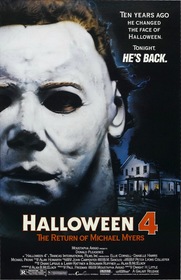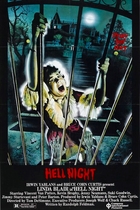Our editor-in-chief Nate Yapp is proud to have contributed to the new book Hidden Horror: A Celebration of 101 Underrated and Overlooked Fright Flicks, edited by Aaron Christensen. Another contributors include Anthony Timpone, B.J. Colangelo, Dave Alexander, Classic-Horror.com's own Robert C. Ring and John W. Bowen. Pick up a copy today from Amazon.com!
Halloween 4: The Return of Michael Myers (1988)
After Halloween III: Season of the Witch became a box-office disappointment and left fans bewildered over the absence of the series' main villain, Michael Myers, producer Moustapha Akkad decided to bring the character back for the next installment. The resulting movie is an attempt to recapture the original film's atmospheric feel and update it for a newer audience. Halloween 4: The Return of Michael Myers is an entertaining film and one of the better in a long line of sequels, though it lacks the suspense that made the first Halloween so successful.
The story picks up ten years after the fiery conclusion of Halloween II, where we are introduced to a seemingly comatose Michael Myers who is about to be transferred to another hospital. After being peacefully loaded into the ambulance, one of the EMTs mentions that Myers' sister and target from the previous sequels, Laurie Strode, has perished in a car accident and left behind a young daughter in Haddonfield, Illinois. Apparently, Myers hears this as well and is not pleased; he quickly dispatches the ambulance crew and escapes into the night. Shortly afterwards, the badly burned and injured Dr. Loomis (the irreplaceable Donald Pleasence, reprising his role from Halloween and Halloween II) finds out about the failed transfer and realizes that Myers is now after his niece, Jamie Lloyd. Loomis rushes to Haddonfield and teams with Sheriff Meeker to locate Jamie before it is too late...
Where this installment really succeeds is in taking some new chances with the Halloween formula, thanks to director Dwight H. Little. The previous Myers-based films opened with Carpenter's classic theme music and some variation of a creepy jack-o-lantern graphic while the credits rolled, but here director Little starts with a menacing silence and a montage of eerie traditional Halloween imagery. It is a simple and subtle change but very effective and starts the film off with a sense of dread and unease before the story itself has even begun. As the film goes on, we are even given a rare look at a bandaged and out of uniform Michael Myers, which is wisely only shown in one quick shot. The viewer is not given time to dwell on the image or to pick it apart, instead it works as a brief visual sting that comes as a bit of a surprise upon your initial viewing. It is easy to become accustomed to (and hence, a little desensitized) to the trademark look of our villain and it's a bit unsettling to see him looking like an escaped experiment from Frankenstein's laboratory. Aside from just delivering a creepy visual, this scene sends us an important message about the character: beneath the well known mask and coveralls is a truly inhuman monster and something to fear.
Writer Alan B. McElroy takes chances of his own in the screenplay. He lets us see some of Dr. Loomis professional struggles as his colleagues speak to him and about him as though he is a crazed nuisance and nothing else. McElroy also gives the town of Haddonfield a somewhat broader scope. We are introduced to not only the soon-to-be teenage victims but also some of the townsfolk. In a fairly realistic turn, the denizens of Haddonfield have not forgotten what happened to their friends, family and neighbors ten years earlier and form a posse to fight back when the police force fails them. Certainly, if this situation happened in a real rural town and there were no police to get in the way, you can believe every hunter, brawler and wanna-be tough guy would be armed and taking to the streets. It's a refreshing change from the typical 'no one believes the hero until it's too late' approach. These slight but noticeable additions to the story give the main characters and events of the film a more realistic base to grow from and make the entire film a little more interesting and believable.
Visually, director Little and cinematographer Peter Lyons Collister successfully create a world of dread where even the day time scenes look foreboding and the shadowy, fog covered nightscapes are surreal and terrifying. Inspired framing, perspective and masterful lighting give every shot of the film a striking sense of clarity and depth that keeps the eye entertained and holds the viewers interest even in the most mundane of scenes.
Sadly, where director Little goes wrong with this film is attempting to stay competitive with other slasher films of the time period. By 1988, the Friday the 13th and Nightmare on Elm Street films, as well as their imitators, had upped the ante on gore and violence and left audiences and filmmakers alike with a certain expectation to push the envelope with each new film. While this may not be a particularly bad thing in some cases, Little makes the mistake of relying too much on crushing skulls and inflicting major damage to the victims and forgets to employ the suspenseful build-ups and exciting payoffs that were the series' trademarks. There are seldom any moments of Myers looming unseen in the background or any of the 'where could he be?' moments that worked so well in the first film or, to a lesser degree, in Halloween II. Without these elements, the scares seem too generic and lack any real serious impact on the viewer.
Luckily, the principal actors pick up much of the slack. Donald Pleasence returns as Dr. Sam Loomis, playing his role with a dark determination and firm sense of authority. The Dr. Loomis who patiently waited for Sheriff Bracket to make time for him on a street corner and nervously pulled his revolver at any bump in the night in the first film is largely gone here - Loomis has become a focused man on a mission who will not take no for an answer nor waste his time waiting when it is time for action. He has no patience for his detractors, barks orders at the police and takes matters into his own hands whenever necessary. Pleasence portrayal here suggests a man who is damaged by his previous experiences, both physically and mentally, and refuses to make the same mistakes that cost lives and left good people in harm's way.
The real star of the film, however, is ten-year-old Danielle Harris. Her character resonates as the ultimate outsider, a confused and hurt little girl who has lost her family and has no place in the world around her because of her relationship to Haddonfield's least favorite resident. She is surprisingly convincing in every emotion she conveys, be it sadness, loneliness or cold hard fear. As the story unfolds and the danger to her character becomes more immediate, it is impossible not to feel for her and root for her survival.
The bottom line is that, while not a great film, Halloween 4 is a damn good one featuring solid performances, strong characters and some interesting twists on the standard formula. Not only that, it is just plain fun to watch - especially on a gloomy October night. For fans of the franchise, or even slasher films in general, this film is well worth your eighty-eight minutes.
This review is part of our Shocktober Classics 2009: Staff Screams event.









Dead tone really reminded of
Dead tone really reminded of an old fashioned horror movie like Falloween. The villian is just a BEAST in this film.